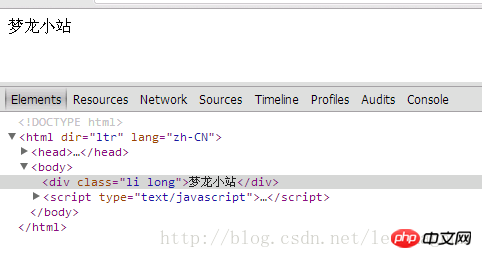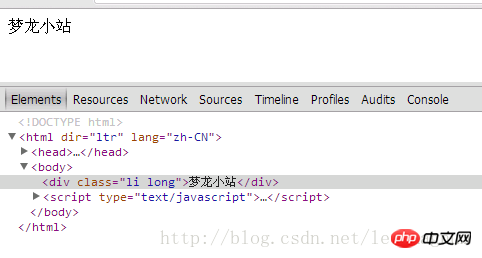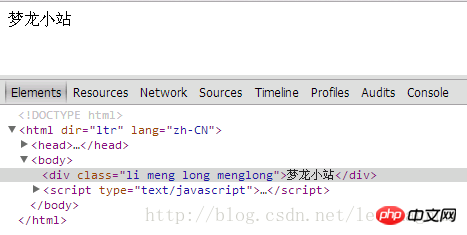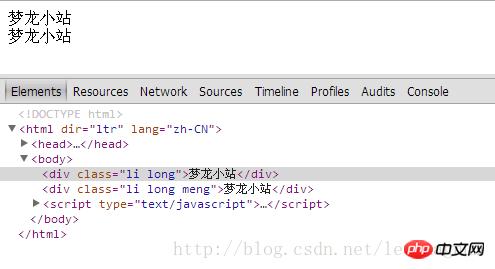classList attribute in HTML5
[Introduction] Previously we introduced some newly added selectors in HTML5, namely querySelector(), querySelectorAll() and getElementsByClassName(). These three have their own unique functions. If necessary, you can read the relevant content in HTML5 actual combat and analysis. Today, I have introduced to you some newly added selectors in HTML5, namely querySelector(), querySelectorAll() and getElementsByClassName(). These three have their own unique functions. If necessary, you can read the relevant content in HTML5 actual combat and analysis. Today I will introduce to you the classList attribute.
What exactly does the classList attribute do? Let’s leave classList alone for now. We consider the question, that is, how do we delete one of the class names among elements with multiple class names? Menglong struggled with his brain and finally came up with a way to achieve it. Delete the class name meng among the three class names li, meng and long. The code is as follows
HTML code
<p class="li meng long">梦龙小站</p>
- JavaScript code
//获取要删除类名meng的p
var p = document.getElementsByTagName("p")[0];
//获取类名字符串并拆分成数组
var allClassName = p.className.split(" ");
//找到要删除的类名
var i, len,
pos = -1;
for(i=0, len = allClassName.length; i < len; i++){
if(allClassName[i] == "meng"){
pos = i;
break;
}
}
//删除类名
allClassName.splice(pos, 1);
alert(allClassName) //li,long
//将其余的类名拼成字符串并重新添加到元素的类名中
p.className = allClassName.join(" ");
Preview effect

<p class="li meng long">梦龙小站</p>
//获取要删除类名meng的p
var p = document.getElementsByTagName("p")[0];
alert(p.classList) //li meng long
p.classList.remove("meng")
alert("p.className: " + p.className) //p.className: li long 
<p class="li meng long">梦龙小站</p>
//获取要删除类名meng的p
var p = document.getElementsByTagName("p")[0];
alert(p.classList.contains("meng")) //true
alert(p.classList.contains("menglong")) //false 3. add(value)
HTML code
<p class="li meng long">梦龙小站</p>
//添加类名 menglong
//获取要删除类名meng的p
var p = document.getElementsByTagName("p")[0];
p.classList.add("menglong");
alert("p.className: " + p.className) //p.className: li meng long menglong 
<p class="li meng long">梦龙小站</p>梦龙小站
//切换类名 meng
//获取要删除类名li的p
var p = document.getElementsByTagName("p");
var i, len;
for(i=0, len = p.length; i< len; i++){
p[i].classList.toggle("meng");
}
alert("p[0].className: " + p[0].className) //p[0].className: li long
alert("p[1].className: " + p[1].className) //p[1].className: li meng long 
The above is the detailed content of classList attribute in HTML5. For more information, please follow other related articles on the PHP Chinese website!

Hot AI Tools

Undresser.AI Undress
AI-powered app for creating realistic nude photos

AI Clothes Remover
Online AI tool for removing clothes from photos.

Undress AI Tool
Undress images for free

Clothoff.io
AI clothes remover

AI Hentai Generator
Generate AI Hentai for free.

Hot Article

Hot Tools

Notepad++7.3.1
Easy-to-use and free code editor

SublimeText3 Chinese version
Chinese version, very easy to use

Zend Studio 13.0.1
Powerful PHP integrated development environment

Dreamweaver CS6
Visual web development tools

SublimeText3 Mac version
God-level code editing software (SublimeText3)

Hot Topics
 CakePHP Project Configuration
Sep 10, 2024 pm 05:25 PM
CakePHP Project Configuration
Sep 10, 2024 pm 05:25 PM
In this chapter, we will understand the Environment Variables, General Configuration, Database Configuration and Email Configuration in CakePHP.
 PHP 8.4 Installation and Upgrade guide for Ubuntu and Debian
Dec 24, 2024 pm 04:42 PM
PHP 8.4 Installation and Upgrade guide for Ubuntu and Debian
Dec 24, 2024 pm 04:42 PM
PHP 8.4 brings several new features, security improvements, and performance improvements with healthy amounts of feature deprecations and removals. This guide explains how to install PHP 8.4 or upgrade to PHP 8.4 on Ubuntu, Debian, or their derivati
 CakePHP Date and Time
Sep 10, 2024 pm 05:27 PM
CakePHP Date and Time
Sep 10, 2024 pm 05:27 PM
To work with date and time in cakephp4, we are going to make use of the available FrozenTime class.
 CakePHP File upload
Sep 10, 2024 pm 05:27 PM
CakePHP File upload
Sep 10, 2024 pm 05:27 PM
To work on file upload we are going to use the form helper. Here, is an example for file upload.
 CakePHP Routing
Sep 10, 2024 pm 05:25 PM
CakePHP Routing
Sep 10, 2024 pm 05:25 PM
In this chapter, we are going to learn the following topics related to routing ?
 Discuss CakePHP
Sep 10, 2024 pm 05:28 PM
Discuss CakePHP
Sep 10, 2024 pm 05:28 PM
CakePHP is an open-source framework for PHP. It is intended to make developing, deploying and maintaining applications much easier. CakePHP is based on a MVC-like architecture that is both powerful and easy to grasp. Models, Views, and Controllers gu
 How To Set Up Visual Studio Code (VS Code) for PHP Development
Dec 20, 2024 am 11:31 AM
How To Set Up Visual Studio Code (VS Code) for PHP Development
Dec 20, 2024 am 11:31 AM
Visual Studio Code, also known as VS Code, is a free source code editor — or integrated development environment (IDE) — available for all major operating systems. With a large collection of extensions for many programming languages, VS Code can be c
 CakePHP Creating Validators
Sep 10, 2024 pm 05:26 PM
CakePHP Creating Validators
Sep 10, 2024 pm 05:26 PM
Validator can be created by adding the following two lines in the controller.






